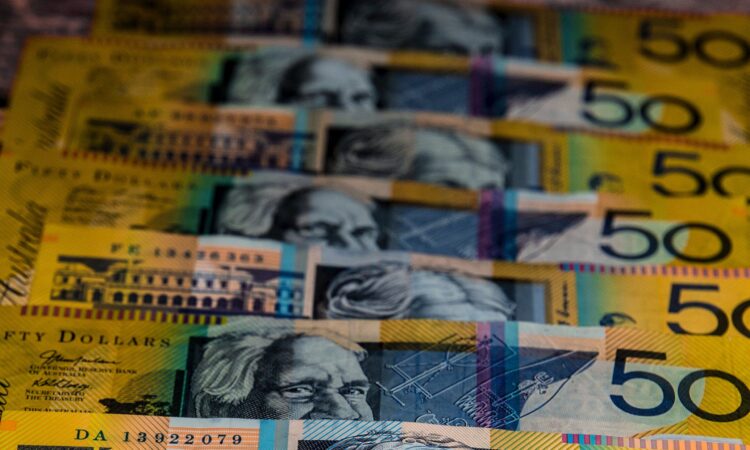
The Australian dollar started off 2023 on a high note, where it enjoyed a brief rise to .71 US cents in January after beginning the month at 0.68 USD.
As Ray Attrill, NAB’s Head of FX Strategy within the Fixed income, Currencies and Commodities Division explains, that’s a 2.5 cents or 3.7% gain across the month.
Nevertheless, the good times were not to last, and by February the Australian dollar had dipped back down again to the 0.68 USD mark, before sliding further to 0.66 USD by early July. And yet, it still had further to go, with the dollar dropping by more than 1% in one week of September alone to a 10-month low of 63.58 US cents. As of September 8, it was trading at 64 US cents and almost two months later, as of November 2, it was still hovering around this mark.
The exchange rate, while demoralising for US-bound travellers, is consistent with previous global crises, such as the GFC (where AUD was at 0.60 against USD) and the Covid-19 pandemic. This recent dip, however, started at the same time many economists were forecasting a US recession–while January’s gains were due to “softer than expected US-inflation related news” coming into the new year, Attrill said.
As the RBA looks to be nearing the end of its rate hike cycle—with one more rate hike tipped at most— let’s take a look at the state of play.
Related: Why Is the Aussie Dollar Falling?
The Australian Dollar’s Outlook in 2022
Last year saw a fluctuation for the price of AUD, with ongoing global crises affecting the market significantly. As the RBA explains, Australia has a floating exchange rate, “meaning the movements in the Australian dollar exchange rate are determined by the demand for, and supply of, Australian dollars in the foreign exchange market”.
Domestically, interest rates and inflation figures also affect how the Australian dollar performs on the foreign exchange market. And against the USD–which has even higher interest rates and inflation than Australia–the AUD has been falling at a steady rate (with some brief increases) for the better part of the last year or so.
According to data from Westpac, the Australian dollar was 0.738 cents to the US dollar in March 2022. In April, 0.736; May, 0.705; June, 0.702; July 0.686; a slight increase in August to 0.696; and back down significantly to 0.667 for the month of September.
That same month–September 2022–Westpac’s chief economist Bill Evans released a statement saying Westpac had “lowered [its] forecast for the AUD by year’s end from USD 0.69 to USD 0.65”.
On December 31, 2022, the Australian dollar was worth 68 US cents.
US Dollar Performance & Drivers in 2022
Speaking to Forbes Advisor, ANZ’s head of FX research Mahjabeen Zaman explains why—despite the market stress occurring globally—the US dollar remained at such a strength during 2022.
Largely, it comes down to the US dollar traditionally providing a safe haven status in times of market stress.
“Other safe haven currencies include the Japanese Yen and the Swiss Franc,” Zaman says.
“In the current cycle however, the US dollar offers a higher interest rate and a yield advantage as opposed to the Yen, which is in a negative interest rate environment, and Swiss Franc, which has much lower interest rates than the US currently.”
This means despite recession fears, the US dollar is still considered to be in a competitive position while the Federal Reserve hikes rates, and to be a safe investment while other “less healthy” currencies decline in value due to global market volatility.
“We expect the US dollar to stabilise once the Federal Reserve slows or approaches the end of its interest rate hiking cycle and when global growth is synchronised,” Zaman says.
The Federal Reserve last raised rates in July, and is adopting a watch-and-see approach to determine if they need to lift rates higher.
AUD to USD: Six-Month Forecast
Much like our own RBA rate rises, it’s unclear as to when the US Federal Reserve will stop its interest rate hiking cycle, although as mentioned above it has indicated that the pace of the hikes is slowing.
As of September, the US inflation rate was 3.2% for the year to July.
Zaman notes that ANZ expected the Australian dollar would appreciate towards the middle of the year. Other banks in the Big Four were in agreement, with Westpac forecasting the AUD/USD exchange to reach 0.70 by June 2023. That view was optimistic, with the exchange rate coming in at 0.66 as of July 7.
In July, the Australian dollar steadied around $0.667 despite the RBA voting to hold the cash rate steady at its July Board meeting.
However, it has dropped to fresh lows in September. Part of this decline can be attributed to the strength of the Greenback in recent weeks: as signs have emerged that China’s growth is slowing, and European economies appear to be facing headwinds, investors have flocked to safe havens like the US dollar.
Australian Dollar to US Dollar Long-Term Forecast
Looking further ahead, Westpac was forecasting an AUD/USD exchange rate of 0.76 by June 2024 and NAB was predicting AUD to be 0.78 to the US dollar by June 2024.
That’s an increase from the bank’s forecasts last September, when Westpac was forecasting the Australian dollar to be worth 0.74 by June 2024 while NAB predicted 0.72 to the dollar for the same time period.
CBA economists have predicted a much more tepid recovery over the next 12 months. The bank predicts the exchange rate would slip over the next quarter to June 2023, and to reach 0.68 by June 2024.
As economists warn of a recession in advanced economies, it becomes less and less likely that the Aussie dollar will stage a spirted comeback in the last few months of 2023, especially in light of China’s slowing economy, which impacts demand for our iron ore.


